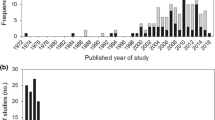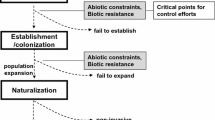Abstract
Established invasions have wide-ranging negative impacts but constraints relating to invader detectability, cost, and efficacy of control may hamper management efforts. One choice that managers face is whether to target control efforts at heavily invaded areas that are sources of invasive propagules or to re-treat previously controlled areas that may be cheaper to control and in which local elimination may be achieved. We developed a mathematical model for the dynamics and control of a plant invasion to determine whether prioritizing heavily invaded or recently controlled areas better achieves each of two management objectives: minimizing the total number of detectable invaded sites (eradication) or heavily invaded sites only (beautification). We provide general guidelines for management by considering how invader traits, budgetary and time constraints, and control efficacy influence prioritization of control efforts and discuss their applicability to long-established invasive plants. For a wide range of invaders and control types, we find that prioritizing heavily-invaded sites performs better for meeting the beautification objective, while re-treating previously controlled sites better achieves eradication. However, combinations of invader traits can lead to the alternate strategy being favored for each management objective, while the optimal choice of management strategy can switch depending on the time horizon of control and annual budget. We summarize model findings to provide general guidelines for invasion managers on how to efficiently allocate limited resources based on invader life history, control cost, and mode of action.






Similar content being viewed by others
References
Abramovitz JN (1983) Pueraria lobata Willd. (Ohwi), kudzu: limitations to sexual reproduction. M.S. thesis, University of Maryland
Alderman DH (2004) Channing Cope and the making of a miracle vine. Geogr Rev 94:157–177
Baxter PW, Sabo JL, Wilcox C, McCarthy MA, Possingham HP (2008) Cost-effective suppression and eradication of invasive predators. Conserv Biol 22:89–98
Bentley KE, Mauricio R (2016) High degree of clonal reproduction and lack of large-scale geographic patterning mark the introduced range of the invasive vine, kudzu (Pueraria montana var. lobata), in North America. Am J Bot 103:1499–1507
Bogich TL, Liebhold AM, Shea K (2008) To sample or eradicate? A cost minimization model for monitoring and managing an invasive species. J Appl Ecol 45:1134–1142
Buhle ER, Margolis M, Ruesink JL (2005) Bang for buck: cost-effective control of invasive species with different life histories. Ecol Econ 52:355–366
Büyüktahtakın İE, Kıbış EY, Cobuloglu HI, Houseman GR, Lampe JT (2015) An age-structured bio-economic model of invasive species management: insights and strategies for optimal control. Biol Invasions 17:2545–2563
Caplat P, Hui C, Maxwell BD, Peltzer DA (2014) Cross-scale management strategies for optimal control of trees invading from source plantations. Biol Invasions 16:677–690
Chadès I, Martin TG, Nicol S, Burgman MA, Possingham HP, Buckley YM (2011) General rules for managing and surveying networks of pests, diseases, and endangered species. Proc Natl Acad Sci 108:8323–8328
Chalak M, Polyakov M, Pannell DJ (2017) Economics of controlling invasive species: a stochastic optimization model for a spatial-dynamic process. Am J Agric Econ 99:123–139
Cook GD, Setterfield SA, Maddison JP (1996) Shrub invasion of a tropical wetland: implications for weed management. Ecol Appl 6:531–537
Courchamp F, Woodroffe R, Roemer G (2003) Removing protected populations to save endangered species. Science 302:1532
Crooks JA (2002) Characterizing ecosystem-level consequences of biological invasions: the role of ecosystem engineers. Oikos 97:153–166
DiTomaso JM (2000) Invasive weeds in rangelands: species, impacts, and management. Weed Sci 48:255–265
Doing H, Biddiscombe EF, Knedlhans S (1969) Ecology and distribution of the Carduus nutans group (nodding thistles) in Australia. Vegetatio 17:313–351
Dunn PH (1976) Distribution of Carduus nutans, C. acanthoides, C. pycnocephalus, and C. crispus, in the United States. Weed Sci 24:518–524
Elton CS (1958) The ecology of invasions by plants and animals. The University of Chicago Press, Chicago
Enserink M (1999) Biological invaders sweep in. Science 285:1834–1836
Epanchin-Niell RS, Hastings A (2010) Controlling established invaders: integrating economics and spread dynamics to determine optimal management. Ecol Lett 13:528–541
Epanchin-Niell RS, Haight RG, Berec L, Kean JM, Liebhold AM (2012) Optimal surveillance and eradication of invasive species in heterogeneous landscapes. Ecol Lett 15:803–812
Follak S (2011) Potential distribution and environmental threat of Pueraria lobata. Cent Eur J Biol 6:457–469
Geerts S, Mashele BV, Visser V, Wilson JRU (2016) Lack of human-assisted dispersal means Pueraria montana var. lobata (kudzu vine) could still be eradicated from South Africa. Biol Invasions 18:3119–3126
Giljohann KM, Hauser CE, Williams NS, Moore JL (2011) Optimizing invasive species control across space: willow invasion management in the Australian Alps. J Appl Ecol 48:1286–1294
Grechi I, Chadès I, Buckley YM, Friedel MH, Grice AC, Possingham HP, van Klinken RD, Martin TG (2014) A decision framework for management of conflicting production and biodiversity goals for a commercially valuable invasive species. Agric Syst 125:1–11
Grevstad FS (2005) Simulating control strategies for a spatially structured weed invasion: Spartina alterniflora (Loisel) in Pacific Coast estuaries. Biol Invasions 7:665–677
Hall RJ, Hastings A (2007) Minimizing invader impacts: striking the right balance between removal and restoration. J Theor Biol 249:437–444
Hall RJ, Gubbins S, Gilligan CA (2004) Invasion of drug and pesticide resistance is determined by a trade-off between treatment efficacy and relative fitness. Bull Math Biol 66:825–840
Hastings A, Hall RJ, Taylor CM (2006) A simple approach to optimal control of invasive species. Theor Popul Biol 70:431–435
Hauser CE, McCarthy MA (2009) Streamlining ‘search and destroy’: cost-effective surveillance for invasive species management. Ecol Lett 12:683–692
Hobbs RJ, Humphries SE (1995) An integrated approach to the ecology and management of plant invasions. Conserv Biol 9:761–770
Hughes MJ, Johnson EG, Armsworth PR (2014) Optimal spatial management of an invasive plant using a model with above- and below-ground components. Biol Invasions 16:1009–1020
Kartzinel TR, Hamrick JL, Wang C, Bowsher AW, Quigley BGP (2015) Heterogeneity of clonal patterns among patches of kudzu, Pueraria montana var. lobata, an invasive plant. Ann Bot 116:739–750
Kopf RK, Nimmo DG, Humphries P, Baumgartner LJ, Bode M, Bond NR, Byrom AE, Cucherousset J, Keller RP, King AJ, McGinness HM, Moyle PB, Olden JD (2017) Confronting the risks of large-scale invasive species control. Nat Ecol Evol 1:172
Lampert A, Hastings A, Grosholz ED, Jardine SL, Sanchirico JN (2014) Optimal approaches for balancing invasive species eradication and endangered species management. Science 344:1028–1031
Leung B, Lodge DM, Finnoff D, Shogren JF, Lewis MA, Lamberti G (2002) An ounce of prevention or a pound of cure: bioeconomic risk analysis of invasive species. Proc R Soc Lond [Biol] 269:2407–2413
Maguire LA (2004) What can decision analysis do for invasive species management? Risk Anal 24:859–868
McCarty MK, Scifres CJ (1969) Life cycle studies with musk thistle. Nebr Agric Exp Stn Res Bull 230:1–15
Miller JH, Edwards B (1983) Kudzu: Where did it come from? And how can we stop it? South J Appl For 7:165–169
Moody ME, Mack RN (1988) Controlling the spread of plant invasions: the importance of Nascent Foci. J Appl Ecol 25:1009–1021
Olson LJ (2006) The economics of terrestrial invasive species: a review of the literature. Agric Resource Econ Rev 35:178–194
Panetta FD, Lawes R (2005) Evaluation of weed eradication programs: the delimitation of extent. Divers Distrib 11:435–442
Pimentel D, Zuniga R, Morrison D (2005) Update on the environmental and economic costs associated with alien-invasive species in the United States. Ecol Econ 52:273–288
Piper CV (1909) The search for new leguminuos forage crops. In: Yearbook of the United States Department of Agriculture. Washington, DC, pp 245–260
R Core Team (2016) R: A language and environment for statistical computing. R Foundation for Statistical Computing, Vienna
Reichard SH, White P (2001) Horticulture as a pathway of invasive plant introductions in the United States: most invasive plants have been introduced for horticultural use by nurseries, botanical gardens, and individuals. Bioscience 51:103–113
Rejmánek M, Pitcairn M (2002) When is eradication of exotic pest plants a realistic goal? In: Veitch C, Clout M (eds) Turning the tide: the eradication of invasive species. Invasive Species Specialist Group of the World Conservation Union (IUCN), Auckland, pp 249–253
Richardson DM, Kluge RL (2008) Seed banks of invasive Australian Acacia species in South Africa: role in invasiveness and options for management. Perspect Plant Ecol Evol Syst 10:161–177
Rout TM, Moore JL, McCarthy MA (2014) Prevent, search or destroy? A partially observable model for invasive species management. J Appl Ecol 51:804–813
Schlaepfer MA, Sax DF, Olden JD (2011) The potential conservation value of non-native species. Conserv Biol 25:428–437
Sharov AA, Liebhold AM (1998) Model of slowing the spread of gypsy moth (Lepidoptera: Lymantriidae) with a barrier zone. Ecol Appl 8:1170–1179
Sharov AA, Leonard D, Liebhold AM, Roberts EA, Dickerson W (2002) “Slow the spread”: a national program to contain the gypsy moth. J For 100:30–36
Sharp RL, Larson LR, Green GT (2011) Factors influencing public preferences for invasive alien species management. Biol Conserv 144:2097–2104
Shea K, Kelly D (1998) Estimating biocontrol agent impact with matrix models: Carduus nutans in New Zealand. Ecol Appl 8:824–832
Shea K, Kelly D, Sheppard AW, Woodburn TL (2005) Context-dependent biological control of an invasive thistle. Ecology 86(12):3174–3181
Shea K, Sheppard AW, Woodburn TL (2006) Seasonal life-history models for the integrated management of the invasive weed nodding thistle, Carduus nutans, in Australia. J Appl Ecol 43(3):517–526
Shea K, Jongejans E, Skarpaas O, Kelly D, Sheppard AW (2010) Optimal management strategies to control local population growth or population spread may not be the same. Ecol Appl 20:1148–1161
Shmida A, Ellner S (1984) Coexistence of plant species with similar niches. Plant Ecol 58:29–55
Simberloff D (2003a) Eradication: preventing invasions at the outset. Weed Sci 51:247–253
Simberloff D (2003b) How much information on population biology is needed to manage introduced species? Conserv Biol 17:83–92
Skarpaas O, Shea K (2007) Dispersal patterns, dispersal mechanisms, and invasion wave speeds for invasive thistles. Am Nat 170:421–430
Susko DJ, Mueller JP (1999) Influence of environmental factors on germination and emergence of Pueraria lobata. Weed Sci 47:585–588
Taylor CM, Hastings A (2004) Finding optimal control strategies for invasive species: a density-structured model for Spartina alterniflora. J Appl Ecol 41:1049–1057
Waldron GE, Larson BM (2012) Kudzu vine, Pueraria montana, adventive in southern Ontario. Can Field-Nat 126:31–33
Welk E (2004) Constraints in range predictions of invasive plant species due to non-equilibrium distribution patterns: purple loosestrife (Lythrum salicaria) in North America. Ecol Model 179:551–567
Williamson M (1999) Invasions. Ecography 22:5–12
Acknowledgements
This work was supported by the National Science Foundation Partnership for International Research and Education (PIRE) program (OISE 0730218). We also acknowledge the suggestions of the handling editor and two anonymous reviewers whose comments substantially improved the manuscript.
Author information
Authors and Affiliations
Corresponding author
Ethics declarations
Conflict of interest
The authors declare that they have no conflict of interest.
Electronic supplementary material
Below is the link to the electronic supplementary material.
Rights and permissions
About this article
Cite this article
Hoffberg, S.L., Mauricio, R. & Hall, R.J. Control or re-treat? Model-based guidelines for managing established plant invasions. Biol Invasions 20, 1387–1402 (2018). https://doi.org/10.1007/s10530-017-1632-9
Received:
Accepted:
Published:
Issue Date:
DOI: https://doi.org/10.1007/s10530-017-1632-9




